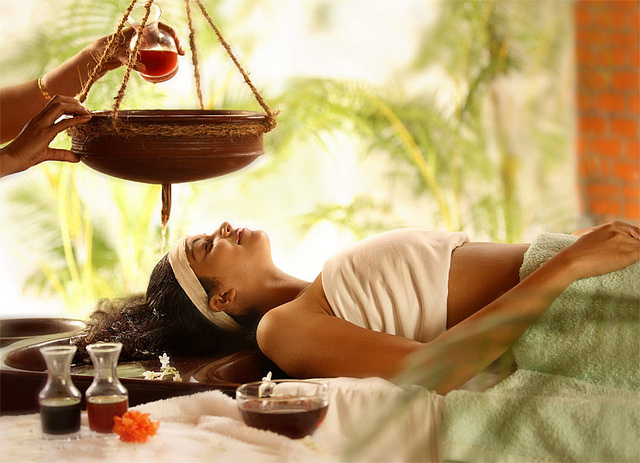*Editor’s Note: No website is designed to, and can not be construed to, provide actual medical advice, professional diagnosis or treatment to you or anyone. Elephant is not intended as a substitute for medical or professional advice, care and treatment.
Panchakarma is an ancient Ayurvedic cleansing program for purification and rejuvenation.
The sanskrit word panchakarma means “five actions,” referring to the five cleansing procedures used to detox the body and mind.
Retreats and spas in many countries now offer this age-old detoxification method. However, attending can be a costly endeavor, with a price-tag ranging anywhere from $1,500-$10,000 (not including airfare)…yikes!
There’s a simple solution: do it yourself!
Before you start, it’s recommended to visit an Ayurvedic Physician to determine your dosha (mind/body constitution) and whether or not panchakarma is right for you. If you get the go ahead, ask if they will serve as a guide in your process if any questions should arise.
Ideally, this program should coincide with a mini-vacation. Try to take off work or school for three to 10 days if possible. Various experiences can arise during cleansing, including release of unresolved emotions, irritability and even slight weakness. The process is meant to release physical, mental and emotional toxins that can hinder your body’s natural ability to heal.
Many report panchakarma as a path toward healing, mental clarity and optimum health.
During this process, listen to your body and do only what feels right. Practice daily meditation (20-30 minutes, twice a day) and perform gentle, restorative yoga to encourage movement and elimination of ama (toxins) in the body.
Prepare for your cleanse. Eat a clean diet of organic, whole foods (keep it light). Ayurveda prescribes “sattvic” or “pure” foods that are easily digested. Consume ghee (clarified butter) or coconut oil, sprouted nuts and seeds, vegetables, fruits, raw honey, spices and herbal teas (avoid dairy and meat products).
Oleate Internally. Consume 2 oz. of warmed, liquified, high quality organic oils such as ghee, flaxseed, hemp or coconut oil to lubricate internally for the duration of the cleanse.
Practice Pranayama. Breathing techniques such as kapalabhati breath and nadi shodhna are incredibly cleansing. They not only clear out stale air and fill the lungs with fresh oxygen, but also increase agni or digestive fire to burn off impurities. Perform pranayama at least once a day.
Take two capsules of Triphala before bed. Do this three days before and during the cleanse. Triphala is an Ayurvedic herb that strengthens the digestive system and encourages elimination.
Sip on ginger tea throughout the day. This is known to increase agni for purification through the skin and bowels.
Eat kitchari for each meal (which consists of a soupy spiced rice and lentils). This can be combined with a juice fast if you prefer.
Perform daily abhyanga massage. This is also known as self-abhy and helps mobilize ama to be released from the tissues.
Directions:
1. Warm an organic oil of your choice (try sesame or coconut) and spread over your entire body from head to toe. Don’t be stingy with the oil; your hands should slide on your skin with ease.
2. Begin at the top of the head and give yourself a scalp massage (like the best salon shampoo treatment you’ve ever had!)
3. Abhyanga massage is firm and invigorating. Use friction-like long strokes on the larger areas of your body (thighs and forearms, for example) and circular motions around all joints.
4. Make sure to give your belly a good rub in the direction of peristalsis (clockwise) to encourage elimination.
5. Don’t forget your face, hands and feet! Note: this should take about 15-20 minutes – take your time and put some love into it!
Sweat. Swedana, or sweating, is a cornerstone of panchakarma, with our skin being the largest organ of detoxification. If you don’t have access to a steam room or sauna, simply make a hot bath with some epsom salts and soak.
Try Oil Pulling. This century-old treatment for dental health promotes major detox. Every morning, take 1-2 Tbsp of coconut oil and swish it around in your mouth as you would mouthwash. After about 10-20 minutes, spit out the saponified oil and dispose.
Use a Neti Pot (Nasya). Use a neti pot for your sinuses every morning before pranayama exercises to clear out the mucous and debris from the night before.
Try an Hebalized Enema (Basti). You can either buy an over-the-counter enema or go traditional by making your own basti.
Directions:
Boil 1 Tbsp of Dashmoola Ayurvedic Herbal blend in two cups of water for five minutes. Strain the water with a cheese cloth and when cooled to body temperature, place in an enema bag with 1 Tbsp organic sesame oil and use as an herbal enema. Retain the basti as it feels comfortable, release when you’re body gives you the queue.
Sip on dosha specific herbal tea. Some prefer to drink “Smooth Move” or other laxative teas at night to encourage further elimination.
Drink Lots of Water. It’s important to stay hydrated through the entire process.
Panchakarma should be a time of quiet introspection and relaxation. Spend time in nature and avoid excess stimulation such as the T.V. or heavy work loads. Reflect, meditate and purify the mind, body, and spirit, from the inside out.
When you are ready to stop the cleanse, slowly start incorporating some fruits, steamed vegetables and warm soups into your diet. Take it easy on your digestive tract for the next few days as you carefully introduce more whole foods into your diet. Let this kickstart a whole new lifestyle of clean eating!
This Ayurvedic form of purification can be done seasonally, or as needed. Make sure to listen to your body, as you will be serving as your own healer in this process.
Love elephant and want to go steady?
Sign up for our (curated) daily and weekly newsletters!
Author: Bess O’Connor
Editor: Emily Bartran
Photo: Adams Homestay Cochin/Flickr


 Share on bsky
Share on bsky





Read 0 comments and reply